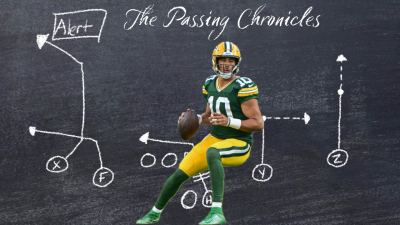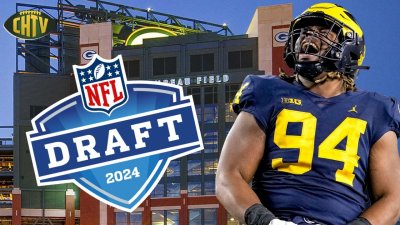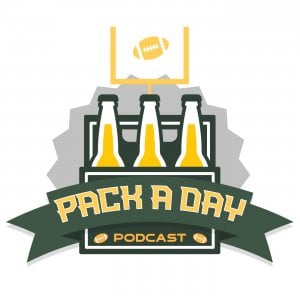X's & O's: Play-Action & The Packers Post-Dig Concept
"Paul Ott Carruth", a former player and coach who wishes to remain anonymous, breaks down the Packers' play-action game.
By PackerAaron
Regular Cheesehead TV reader (and all-too-infrequent commenter) "Paul Ott Carruth", a former player and coach who wishes to remain anonymous, breaks down different aspects of the Packers from an X's and O's standpoint. Today he breaks down the Packers' play-action game and the running game that sets it up.
Bill Walsh, the legendary coach of the San Francisco 49ers, once said, if run correctly, the playaction pass is the toughest play in football to defend. He’s right. But what’s required to execute the play action pass? First, you have to be able to run the ball. More on that in my final thoughts. Second, you have to be able to present the illusion of run (low pad level, good ball faking, etc.) The Packers do both effectively. One of the staple play action plays the Packers run is the Post Dig concept. I have a static diagram to explain and an animated Power Point. The Power Point is from Office 2010. Let’s go to the diagram.
Diagram Explanation
In the diagram I’ve placed the Packers in 21 Personnel (2 backs 1 TE). This is a traditional Pro I Formation the Packers will use when they are in two back formations and under center. I’ve drawn the defense in a vanilla 4-3 Cover 2. The #1 receivers are the only two receivers running designated routes. This makes the protection scheme an 8 man protection (Max Protect). The backs will serve as checkdowns should the linebackers bail out in coverage instead of charging hard on their run fits.
This is what happened on the pass play to Grant in the Red Zone. The idea behind this route concept is to attack the safeties. The #1 receiver to the weakside is running a deep post, drawing the FS in to coverage. The #1 receiver on the strongside is running a deep in or dig route. This is the route that will most likely pop open if the SS executes his deep half drop and if the linebackers suck up to stop the run. The weak area is right between the linebackers and the safeties dropping to their deep halves. Because the SS has to squeeze off of the hash mark to potentially cover a vertical threat in his deep half, the dig route takes advantage of his movement and gives the receiver leverage inside. If everything goes to plan, the QB has a clear throwing window. The only defender who could remotely make a play on the ball is the weakside corner who has passed off the post to the FS. It is also possible that the Will linebacker could make a play if he were not as aggressive in the run game. You may recall Derrick Brooks from the Buccaneers being an interception machine at this position for this very reason.
What the Packers are executing is in virtually every NFL playbook. The difference is the Packers execute it better than most. What about the backs? Well, they, along with Rodgers, are executing a lead play. If this were to be run to the weakside, it would be an isolation on the Will linebacker. When the Packers call any playaction they will use the term “Fake” in their play call. For example, “Pro Right, Fake 96 Bag, X Post Z Dig.” The “Fake 96 Bag” tells the team to fake that run play. It doesn’t get any more straightforward than that.
Final Thoughts
By now most of you have heard commentator after commentator say, “The Packers can’t run the ball.” Anyone who believes this statement is either ignorant or delusional. The Packers can run the ball. They do it every game. How many times has Aaron Rodgers reversed or fronted out from under center and given the ball to a back? How many times has he given the ball to a back from the shotgun? I may have been only an average Math student in college but I can count. In all fairness, what they mean to say is, “The Packers don’t run the ball very well.” Fair enough. If you compare them to the Atlanta Falcons, Chicago Bears, Tennessee Titans, or any other team that centers their offense around the running back, then yes, the Packers don’t run the ball very well. Einstein said “everything is relative.” What the commentators are overlooking, in my opinion, is the role the running game plays in the Packer offense. The Packers do not line up and try to play power football with their opponents. From my perspective, this is the intent of the running game for the Packers:
1) They run to stay on schedule (manageable down and distances)
2) They run to set-up their play action pass (see above)
3) They run to ice games when they feel they can (see Minnesota game #1)
I don’t believe they run to gain yards (now I sound like a commentator). What I mean to say is the Packers don’t use the run as their primary method of advancing the ball. When Rodgers said to ESPN Monday night that teams have been content playing coverage against them (meaning 2 high safety looks) he’s right. Can you blame opponents for playing more coverage than sending more pressure and playing man or man free? The way Rodgers has been beating blitz coverage is enough to put any coordinator back on their heels. It really boils down to “quick death or slow death.” Do you let Rodgers torch you versus single coverage and get the quick strike or do you make them drive the ball in smaller chunks hoping the Packers make a mistake in the course of a drive? “Waiter, I’ll take the slow death with a side of humiliation.” Any way you look at it, right now, Rodgers is going to make you bleed, be it slow or quick. It’s like choosing death by a jugular shot or death by a million paper cuts. Both options suck, the result is the same, but one keeps you hanging on for a while. Unlike Atlanta and Chicago, the Packer offense runs (no pun intended) through Rodgers and not through Grant and Starks as it does through Turner and Forte respectively.
When assessing the Packer running game look at short yardage run success on 3rd down and the number of lost yardage plays from the running game. This can be a good barometer of run game efficiency instead of aggregate yards or even yards per carry (although, ypc carries more weight than total run yards).
(Click the link above to download a slideshow animation in Power Point. Click on the slide to animate it.)
PLEASE SUBSCRIBE TO OUR CHEESEHEAD NATION WEEKLY NEWSLETTER HERE.
__________________________














Comments (7)
November 16, 2011 at 11:27 am
I love the Xs & Os posts. Thanks for the education.
November 16, 2011 at 01:14 pm
Many thanks. I love these articles.
Are the powerpoint animations difficult to make please? I would like t make some of my own, but would have to buy powerpoint as I don't have it. Is there anything better to make Xs and Os animate or is that the easiest/best?
Also is there a link anywhere for past articles by this author please?
PackerAaron
November 16, 2011 at 01:39 pm
Here's a good spot for all of POC's articles: http://cheeseheadtv.com/blog/google-search?cx=010409922688294922632%3Aaz...
November 16, 2011 at 01:43 pm
thanks (:
November 16, 2011 at 09:05 pm
You can use OpenOrifice to make PP style presentations. (I prefer the Beamer LaTeX class, but you need to know a bit of LaTeX for that.) If you really needed to, you could put together some images using Paint or the GIMP or something.
November 16, 2011 at 03:54 pm
I like our running game. I've seen way bigger gains on run this year than the last few. (remember the Kuhn and Jackson tandom)
I also remember MM talking about hitting his magic number of carries last year. He was shooting for 20-30 per game for the balanced attack. It never seemed to happen. This year is a huge upgrade and it's obvious by the success of the play action and more positive rushing yards per play. (minus grants carries this last game).
November 16, 2011 at 11:27 pm
Fantastic stuff Paul! Thanks much!